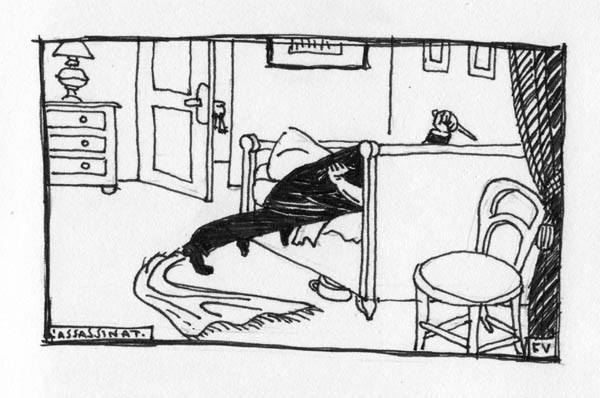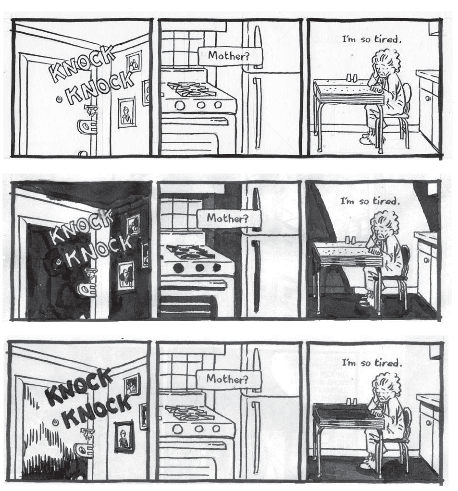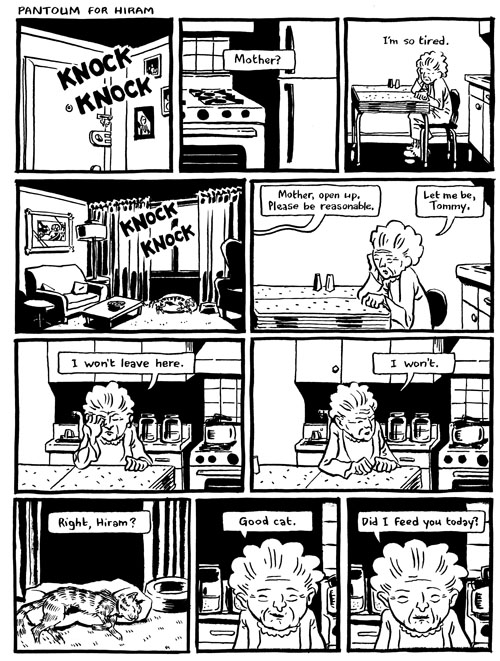Into the inky black
This is the second of a two-part post where I walk you through the method I used to make a typical comics page. (for part I, go here). In part one I went over my way of doing thumbs and pencils and got through inking lettering and panel borders. This part is about my process of inking a comics page. There are tons of ways to create a comics page and this is just one of them, submitted for your approval, adoption, or rejection. It is also an excerpt from chapter six of Mastering Comics.
I ink starting with lettering, then word balloons and panel borders. I usually use a Hunt 102 or 22 nib pen for lettering and a T-square and ruling pen to rule borders, but I may use different tools depending on the look I want for the story. For example, the panel borders we see here were ruled out in pencil but inked freehand with a brush.
Once the lettering and borders are done, I ink all the main line-work on the figures and backgrounds. This is often done with a nib pen, but sometimes I use brush as well. In the example, I mainly used a Hunt 102 nib, but also used a more flexible nib like a Hunt 100 or the Gillott 290 to get more lively lines on the old woman, which you can see in the finished page at the end of this post. (By the way, see our supplies Quickguide for information about these tools; see also DW&WP Chapter 8.)
The next step is adding tone and spotting blacks.
In this story, I decided to use only solid black and no tone to give the comic a stark look. As I am developing a new comic, I often look at other comics, art, film, and photography to find inspiration for an appropriate style. I did a post a while back on my personal blog where I shared some of my early studies for this comic, including this copy of a woodcut by the early 20th Century artist Felix Vallotton (sorry, it’s a little lurid!):
I’ll often scan or photocopy my basic linework at a reduced size so that I can sketch out different ideas directly on the copies, as shown below. I tend to use a brush and ink, but marker or even Sharpie can work at this stage.
Once I’m settled on the balance and placement of the blacks, I’ll start working on the final pages (penciling in shadow lines and the like as needed). At this point, things pick up pace and cartooning feels fun!
I then scan my pages (see Chapter 9 in Mastering Comics, as well as DW&WP, Chapter 14 and the Scanning quickguide) and do some last cleanup and correction on the files. Many people do all of their corrections on the computer now; some artists even do black-spotting in Photoshop. It’s certainly more efficient that way, but I like to have my original pages look as complete as possible.
This kind of method really works, and the great thing about it is that you can break it down into as many steps as you need to. It’s perfect if you’re someone who only achieves the drawing you want after a lot of tracing and redrawing. It’s also useful if you’re drawing complex spaces or strange poses. But it’s a lot to do; it’s a lot of steps, and it can be daunting. It also requires a light box and a computer and scanner, which you may not have available to you.

After doing some corrections on the bristol board with white ink, I do fine-tuning on the scanned file.
Whether you ever use a tracing-based complete method or not, take these tips home:
1. When you’re stuck, try sizing your thumbs up and tracing. That can jump-start you.
2. Start with loosely blocking in all your main figures, fore- ground objects and space, and lettering. Then tighten up and add background.
3. When you’ve got a tough background to do, try drawing it separately and tracing it in (just make sure your character is placed in it properly; i.e., standing on the floor, at the correct scale).
4. Have a friend pose when you can’t nail a gesture.
5. If your pencils get too worked over, trace them onto another sheet of paper to ink.
6. If you’re in a situation in which you are having a hard time making time to work on comics, you can divide the production of an individual page into many, many small tasks. Simply scanning, sizing, and printing thumbs is an important step, one that you could do in 20 minutes and know you’ve done something on your comic that day.
For more on tracing, and a step- by-step how-to, see DW&WP Chapter 8.2.
***
By the way, here’s that finished tier in the context of the whole page, it comes from a 4-page story called “Pantoum for Hiram” which has not yet been published:


























